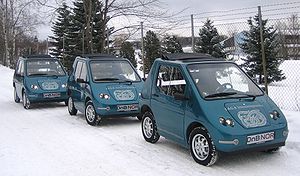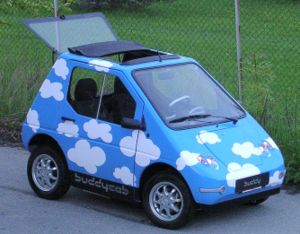.gif)
Buddy (electric car)
Encyclopedia

Norway
Norway , officially the Kingdom of Norway, is a Nordic unitary constitutional monarchy whose territory comprises the western portion of the Scandinavian Peninsula, Jan Mayen, and the Arctic archipelago of Svalbard and Bouvet Island. Norway has a total area of and a population of about 4.9 million...
electric car
Electric car
An electric car is an automobile which is propelled by electric motor, using electrical energy stored in batteries or another energy storage device. Electric cars were popular in the late-19th century and early 20th century, until advances in internal combustion engine technology and mass...
, produced by Pure Mobility, formerly Elbil Norge AS, at Økern in Oslo
Oslo
Oslo is a municipality, as well as the capital and most populous city in Norway. As a municipality , it was established on 1 January 1838. Founded around 1048 by King Harald III of Norway, the city was largely destroyed by fire in 1624. The city was moved under the reign of Denmark–Norway's King...
. In 2007, the Buddy, and its predecessor, the Kewet
Kewet
Kewet was the brand name of an battery electric vehicle. Since 2007, it has been manufactured under the name Buddy by ElbilNorge AS in Oslo, Norway.-History:...
, made up 20% of the electric cars in Norway
Norway
Norway , officially the Kingdom of Norway, is a Nordic unitary constitutional monarchy whose territory comprises the western portion of the Scandinavian Peninsula, Jan Mayen, and the Arctic archipelago of Svalbard and Bouvet Island. Norway has a total area of and a population of about 4.9 million...
.
History

Kewet
Kewet was the brand name of an battery electric vehicle. Since 2007, it has been manufactured under the name Buddy by ElbilNorge AS in Oslo, Norway.-History:...
electric vehicle
Electric vehicle
An electric vehicle , also referred to as an electric drive vehicle, uses one or more electric motors or traction motors for propulsion...
. Originally the Kewet was developed in Hadsund
Hadsund
Hadsund is a town with a population of 5,040 in Mariagerfjord municipality, Region Nordjylland on the east coast of the Jutland peninsula in northern Denmark....
, Denmark
Denmark
Denmark is a Scandinavian country in Northern Europe. The countries of Denmark and Greenland, as well as the Faroe Islands, constitute the Kingdom of Denmark . It is the southernmost of the Nordic countries, southwest of Sweden and south of Norway, and bordered to the south by Germany. Denmark...
, and the first model was made in 1991. Production alternated between Hadsund, Denmark and Nordhausen
Nordhausen
Nordhausen is a town at the southern edge of the Harz Mountains, in the state of Thuringia, Germany. It is the capital of the district of Nordhausen...
, Germany
Germany
Germany , officially the Federal Republic of Germany , is a federal parliamentary republic in Europe. The country consists of 16 states while the capital and largest city is Berlin. Germany covers an area of 357,021 km2 and has a largely temperate seasonal climate...
. During the first five generations over 1000 electric vehicles were produced. The vehicle was sold in eighteen countries. In 1998 all rights were acquired by ElBil Norge AS (which at the time was called Kollega Bil AS). Bil is the Norwegian word for car (as in automobile), Norge is the Norwegian word for Norway. For some years ElBil Norge further developed the electric vehicle and in the autumn of 2005 a new model was presented that was first called Kewet Buddy Citi-Jet 6, but is now known simply as the Buddy.
In 2010, Pure Mobility (former "Elbil Norge") launched a brand new version of the Buddy. It was initially marketed as "MetroBuddy", but the "Metro" prefix was removed due to certain negative or confusing associations with the term.
Technology and production
Buddy is a simple, functional, electric city car with a range of 20 – depending on season, topography and driving style. Maximum speed is 80 kilometres per hour (49.7 mph). Its length is 244 centimetres (96.1 in), which means that in some jurisdictions it can be legally parked sideways.The Buddy consists of a strong, hot galvanized steel tube frame, complete with safety cage but with no proper deformation zones. The body is made of thin fiberglass. Other metal parts are treated so that further rust treatment is unnecessary. The electric motor
Electric motor
An electric motor converts electrical energy into mechanical energy.Most electric motors operate through the interaction of magnetic fields and current-carrying conductors to generate force...
is a 72V Sepex 13kW, a direct current motor with brushes. Well tried technological solutions have used to ensure maximal reliability. The car has no servo or aids regarding steering and braking. The response and "connection" to brakes and front wheels are vague and difficult to dosage. The vehicle also lacks safety equipment such as ABS, ESP, Airbags etc.
Currently, the Buddy is delivered with lead batteries. Completely discharged batteries can be recharged in 6–8 hours. The batteries can be rapidly charged so that one hour's charging allows the vehicle to be driven about 10 kilometres (6.2 mi). Charging requires an ordinary, grounded outlet with a minimum circuit of 10 A. The life expectancy for the batteries is expected to be between two and five years, or about 20 000 km, depending on driving and charging habits. A complete battery set costs from £2 800 excluding value added tax.
ElBil Norge has made a development fleet of Buddy vehicles equipped with various forms of Li-Ion battery technology. When this technology is made available commercially, existing Buddy vehicles will be upgradeable to the new technology.
The Buddy is EU approved by the Vehicle Certification Agency as an electric four-wheel motorcycle aka. Heavy Quadricycle. It can be used as an ordinary vehicle without restrictions as to the roads it can be driven on, and drivers require only an ordinary driving license.
Two models of the Buddy are currently available, the ordinary variety and BuddyCab which features a folding roof. In 2007 the production capacity at Økern in Oslo is 5-6 vehicles a week, with a theoretical production capacity of 500 vehicles annually. To meet international needs ElBil Norge is working to establish new production localities. Despite international interest, the Buddy is currently sold only in Norway while the company prepares for export.
As of late 2008, plans were under way for an additional factory in Portugal
Portugal
Portugal , officially the Portuguese Republic is a country situated in southwestern Europe on the Iberian Peninsula. Portugal is the westernmost country of Europe, and is bordered by the Atlantic Ocean to the West and South and by Spain to the North and East. The Atlantic archipelagos of the...
. The aim is to produce 5000 cars a year.
Information

Current annual production of electric cars is 4,380. Buddy ranks 29th in terms of sales by automotive brands in Norway in 2006, ahead of Jaguar, Fiat, Smart and Porsche. Most cars are black/dark/grey/silver, about 80% of Buddys are delivered in strong, bright colours with many using bold decorative elements: flowers, hearts, clouds, and flames – and a multitude of colours. One Buddy was designed to match the owner's night table lamp.
Operations and Ownership
Buddy is produced by Pure Mobility (formerly known as "ElBil Norge AS") which in 2003 changed its name from Kollega Bil AS. The company was originally established in 1992 and has been in the electric vehicle branch since that time. Managing director is Kjell Strøm. Elbil Norge AS is owned by the original founders Jan-Petter Skram and Viggo Vargum, in addition to external investors which include Hafslund Venture AS, Gezina AS (Th. Brøvig), members of the Selvaag family, Lychegaarden (Jens P. Heyerdahl) og Jan Chr G Sundt. The owners have expanded the company gradually. In 2005, an emission NOK 12 million financed by the existing owners allowed for an expansion of the Økern factory. ElBil Norge had a profit in 2004 and 2005 and has a ratio of owner equity to debt of 90%.See also
- Government incentives for plug-in electric vehiclesGovernment incentives for plug-in electric vehiclesGovernment incentives for plug-in electric vehicles have been established by several national and local governments around the world as a financial incentive for consumers to purchase a plug-in electric vehicle....
- List of modern production plug-in electric vehicles
- Plug-in electric vehiclePlug-in electric vehicleA plug-in electric vehicle is any motor vehicle that can be recharged from any external source of electricity, such as wall sockets, and the electricity stored in the rechargeable battery packs drives or contributes to drive the wheels...

